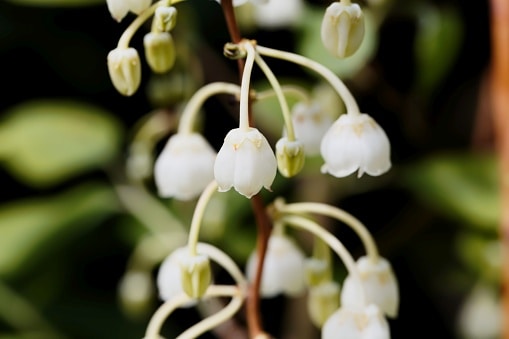Honeycup, or Zenobia pulverulenta, is a semi-evergreen shrub with an upright, spreading habit that gets covered in long, spindly, red stems that are slightly waxy in texture. The green-blue or grey-green leaves have a thin texture and turn yellow or reddish-gold color in the fall. In late spring, Honeycup also produces small clusters of white, bell-shaped flowers, which have an anise-scent. They are often confused with lily of the valley, but are a much slower-growing plant that prefers moist soils, often located near streams and rivers.
How to Plant
Honeycup needs full sun or partial shade to thrive. The type of soil also matters, as it prefers moist, sandy and acidic soils with a pH range from 4.5 – 6.5. If you are planting in pots, use a combination of peat moss and perlite. When planting in the ground, make sure you mix compost in the soil. Honeycup requires regular watering, especially in sultry climate, so the soil around the roots should remain evenly moist. Fertilizing it is not necessary, but it will help it grow.
Meaning and Symbolism
The genus name of Zenobia pulverulenta is derived from the Latin word pulverulenta, which translates to “dust-like” or “powdery”, which refers to its small leaves and waxy, slightly powdery texture. It is also often referred to as “Lily of the Valley”, because of its resemblance to the beloved and popular ornamental flower.
History, Mythology, and Religious Significance
The Honeycup flower has been popular since ancient times. It has been mentioned in multiple Homeric Hymns from seventh century BC, and was said to have been used to create a garland for welcoming visitors and as offerings to the gods. It was also a treasured symbol in the courts of medieval and Renaissance Europe, and was given in matrimonial, religious, and diplomatic ceremonies.
Flower Varieties and Their Defining Characteristics
Honeycup comes in three main varieties – the Honeycup, the white star-of-Bethlehem, and the pale jewelweed. The honeycup variety has wavy-edged green or gray leaves and long, red stems. It prefers moist soils near streams and rivers. The white star-of-Bethlehem variety is a similar shape as the Honeycup but has white star-shaped flowers. The pale jewelweed is a larger, shrubbier variety and has yellow-orange tubular flowers.
How to Pot and Repot
When potting your Honeycup, choose pots with good drainage and only fill them halfway with soil. Do not plant too deeply, as Honeycup does not like to be crowded and needs to be able to spread its roots. When repotting, if the roots look congested you can use sharp scissors to trim back the roots that are wrapped around the root ball, before transferring the plant to a larger pot.
How to Prune
Honeycup requires regular pruning, especially after flowering. If necessary, you can prune the shrub back fairly hard in early spring, to encourage growth and create a more compact form. Pruning after flowering can also help to shape the shrub and remove any weak or diseased stems, as well as thin out any crowded areas.
How to Propagate
Honeycup is best propagated through stem cuttings taken in the late spring or early summer. It is recommended to take cuttings approximately 4 to 6 inches in length and wait for a callous to form on cut ends. Once the cuttings are ready, plant them in moist potting soil with good drainage. Place them in a bright, warm spot and keep the soil consistently moist.
Common Pests and Diseases
Honeycup is generally considered to be a low-maintenance plant, although it can be susceptible to certain pests and diseases. Aphids, scale insects, and spider mites are the most common pests that can affect your Honeycup, and can be treated with natural insecticidal soaps. As for diseases, Honeycup is more resistant to common plant diseases, such as rust or powdery mildew, but can still be affected. To prevent any damage, ensure that your Honeycup is planted in well-draining soil, and is given plenty of air circulation around the leaves.
Frequently Asked Questions
What is Honeycup?
Honeycup is a semi-evergreen shrub, with waxy green to gray leaves and small clusters of white, bell-shaped flowers. It is sometimes called “Lily of the Valley” because of its resemblance to the popular ornamental flower.
What type of soil does Honeycup need?
Honeycup prefers moist, sandy acidic soils with a pH range from 4.5 to 6.5. If you are potting, use a good mix of peat moss and perlite. When planting in the ground, mix in some compost to the soil.
How often should Honeycup be watered?
Honeycup needs regular watering and the soil should remain evenly moist. The amount of water it needs will depend on the temperature and humidity. In warmer climates, it may need to be watered more often than in cooler climates.
Table Fact Sheet
| Name | Honeycup, Zenobia pulverulenta |
|---|---|
| Family | Balsaminaceae |
| Plant Type | Perennial shrub |
| Mature Size | 2-3 feet tall and 4-5 feet wide |
| Sun Exposure | Full sun to part shade |
| Soil Type | Moist, sandy, acidic soils |
| Soil pH | 4.5-6.5 |
| Bloom Time | Late spring to early summer |
| Flower Color | White |
| Hardiness Zones | 5-9 |
| Native Area | Eastern United States |
What we love from Amazon this week
Buy these wonderful flowers directly from Amazon:















